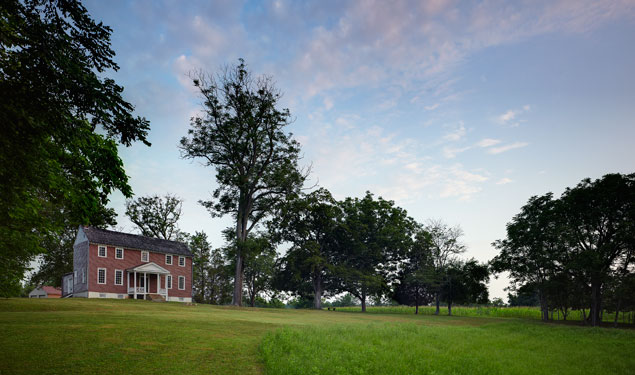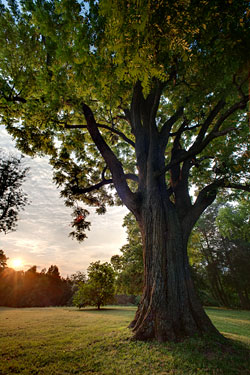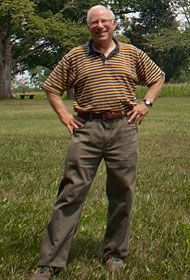

Photograph © Allen Russ
I hope this sends a message not only to Wal-mart, but to other developers that the preservation community is willing to fight for historic sites. — Robert D. Rosenbaum
History of Wilderness Battlefield

The opening battle of Union General Ulysses S. Grant’s sustained offensive against the Confederate Army of Northern Virginia, known as the Overland Campaign, was fought at the Wilderness from May 5-7, 1864. Located in rural Orange County, Virginia, the Wilderness battle was also the first time Union General Ulysses S. Grant and Confederate General Robert E. Lee met in combat. On the morning of May 5, the Union V Corps attacked Lt. General Richard S. Ewell’s Corps on the Orange Turnpike. Later that day, Brigadier General George W. Getty’s Division (VI Corps) and Major General Winfield Scott Hancock’s II Corps met the Confederate corps of Lieutenant General A.P. Hill’s on the nearby Plank Road. Fighting was fierce, but inconclusive as both sides attempted to maneuver in the dense woods. Darkness halted the fighting, and both sides rushed forward reinforcements. At dawn on May 6, Hancock attacked along the Plank Road, driving Hill’s Corps back. Lt. General James Longstreet’s corps arrived in time to prevent the collapse of the Confederate right flank, however, a flank attack in Hamilton’s Thicket failed when Longstreet was wounded.
The battle at Wilderness was a tactical draw. More than 160,000 troops were engaged, with an estimated 29,000 casualties. Grant, however, did not retreat, instead, he decisively advanced the Union troops toward the crossroads of Spotsylvania Courthouse. Not only was Wilderness the bloodiest campaign in American history, it was the turning point in the war in the Eastern Theatre. For these reasons, the Congressionally-appointed 1993 Civil War Sites Advisory Commission identified the Wilderness as a Priority I, Class A battlefield—its highest designation.
In 2008, Wal-mart Stores, Inc. applied for a Special Use Permit to construct a 138,000 square-foot superstore on a section of the Wilderness Battlefield that Pulitzer Prize-winning author and historian James McPherson would later identify as part of the "nerve center of the Union Army" during the tragic and bloody 1864 battle. The following year, over the objections of area residents and preservationists alike, local officials gave the Bentonville, Arkansas-based corporate giant permission to proceed with its plans to put a big-box store atop this irreplaceable American landmark.
Together with colleagues from the firm Arnold & Porter, Washington, D.C.-based attorney and steward Robert D. Rosenbaum worked tirelessly with concerned citizens and the Wilderness Battlefield Coalition—a group consisting of the Civil War Trust, Friends of Wilderness Battlefield, National Parks Conservation Association, National Trust for Historic Preservation, Piedmont Environmental Council, and Preservation Virginia—to build a strong and detailed case for the historical significance of the proposed Wal-mart site, enlisting the help of such notables as the aforementioned Dr. James McPherson. Until recently, it seemed that the same fate would befall this key portion of the Wilderness Battlefield. As the trial in the matter was beginning, however—following months of preparation by the Arnold & Porter team—Wal-mart announced that it had "decided to preserve" the Wilderness site. At the Wilderness Battlefield, Mr. Rosenbaum not only saved a national treasure, but has also provided a successful framework with which to take on even the most awesome of adversaries.
Although he retired from full-time litigation in 2007 after more than 40 years of practice, Mr. Rosenbaum continues to be active at Arnold & Porter's DC offices. Today, his caseload consists entirely of pro bono work to protect our nation's cultural and historical heritage.

Photograph © Allen Russ
Threat
Fully 20% of the hallowed ground where the Civil War's battles were fought has already been destroyed or compromised, covered by roads, housing or commercial development. Despite Wal-mart's decision not to build at the Wilderness, today, much of the battlefield remains in jeopardy. Located in the greater Fredericksburg region, one of the fastest-growing areas in Virginia, the pastoral surroundings of the Wilderness is quickly becoming a magnet for commercial development. Current property owners are exploring development that could negatively impact the visitor experience at both the battlefield and the park resulting in jarring visual intrusions and obstructions. Ultimately, such incompatible development could increase pressure on local officials to widen and realign local roads, specifically Virginia's State Route 20, which runs through the heart of the Wilderness Battlefield.

